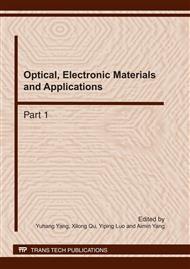p.617
p.621
p.625
p.630
p.635
p.640
p.645
p.649
p.654
Preparation and Dielectric Properties of POSS-NH2/Cyanate Ester Resin Organic-Inorganic Hybrids
Abstract:
In order to improve the dielectric and overal properties of cyanate ester (CE) resin, a functional POSS monomer(octa(aminopropyl)silsesquioxane, POSS-NH2), was employed to modify CE. A series of POSS-NH2/CE hybrids (CE, CE1, CE2, CE3 and CE4) containing different content of POSS have been prepared by melt casting and then curing. The curing reaction of the resin systems were monitored by FT-IR. Dielectric properties of the hybrids were investigated in detail. FT-IR results showed the almost disappearance of the –OCN for all resin systems, suggesting the complete curing of CE using the experimental curing technique. Dielectric investigation indicates that CE1 which contains 1 wt% of POSS has the best dielectric properties with not only lowest dielectric constant but also lowest dielectric loss.
Info:
Periodical:
Pages:
635-639
Citation:
Online since:
March 2011
Authors:
Price:
Сopyright:
© 2011 Trans Tech Publications Ltd. All Rights Reserved
Share:
Citation:


